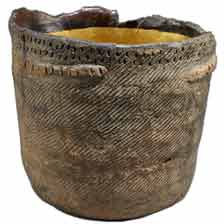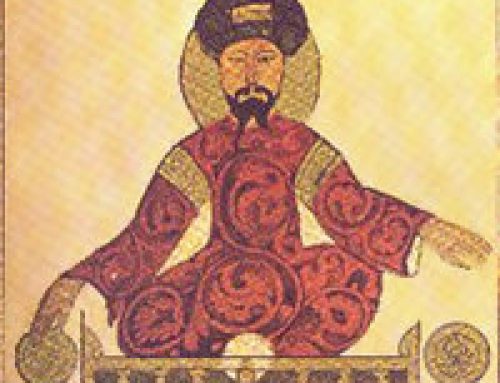
Ancient history timeline: Building at Gobekli Tepe in what is now Turkey (ca. 9000 BC)
Beginning of farming
Around 10,000 BC, with the end of the last major Ice Age, people all over the world – not everyone, but a lot of people – began to shift from fishing and hunting and gathering to farming as their main way of getting food.
Farming in Africa and West Asia
North Africans, Egyptians, and West Asians were already farming figs, and now they added barley and wheat, chickpeas and lentils. They made beer out of the barley, and they learned from Central Asians how to make pottery to drink it in. They started to build stone temples like this one at Gobekli Tepe, and mud-brick houses in towns like Jericho and Catal Huyuk. Around 8000 BC, they also began to grow grapes and make wine. By 6000 BC West Asian people were planting olive orchards to get olive oil.
Farming in South America, Central Asia, India, China, and Japan

Clay people from Mehrgahr, Pakistan, about 7000 BC
People started farming in other places too. By around 8000 BC, South American people in Ecuador and Peru were growing squash and potatoes, and soon after that they were growing chili peppers and corn. In Brazil they grew yuca root and peanuts, instead. In Southeast Asia, it was bananas and plantains. Around 7000 BC, people were growing rye for rye bread and planting apple trees in Central Asia. People were growing wheat and barley at Mehrgahr in what’s now Pakistan and all over India. By 6000 BC, people in southern China – and possibly some Jomon people in Japan – were growing rice. Then about 5000 BC, South Americans added beans to their squash and corn.

Ancient history timeline: Standing stones at Nabta Playa (modern Sudan), ca. 6000 BC
Domesticated animals
Along with farming, people also began to keep farm animals. By about 10,000 BC, people in Central Asia and Europe were beginning to keep pigs. In South-East Asia and southern China, they were keeping chickens by around 7000 BC, and people started to keep sheep in West Asia and Egypt about the same time. By 5500 BC, people in Central Asia had also tamed the wild aurochs and turned them into cattle, which they kept for both meat and milk (and yogurt and cheese).
Around 5000 BC, South Americans were raising guinea pigs for their meat, and by about 4000 BC, they were keeping llamas too. Also about 4000 BC, people in Sudan tamed donkeys.

Ancient history timeline: Jomon pottery with rope impressions (5000 BC, now in the British Museum)
Spinning and weaving clothing
Once people were farming, they also started to grow crops to make rope and clothing too. About 5000 BC-4000 BC people all over the world began to spin and weave clothes out of flax and hemp, cotton and wool.
Still people kept experimenting with new crops. By 4500 BC, they were growing millet and probably peaches in China. By around 4000 BC, people in Sudan, south of Egypt, were growing dates and millet and in Aksum (modern Ethiopia) they were growing another kind of grain, teff. In both West Africa and East Africa, people were pressing palm nuts for palm oil. About the same time, Peruvian people were growing avocados.

Ostrich egg from Sudan, ca. 4400 BC
People evolve whiter skin, and drink milk
But not all of the changes of this time were things people invented. People also continued to evolve naturally. Some people evolved to be able to digest milk; some people evolved to be able to digest wheat better. As people traveled further north, their children evolved to have whiter skin, because there wasn’t as much sunshine and they needed to soak up more sunshine to make enough Vitamin D to stay healthy. Sometime around 4500 BC, in Europe, the first people evolved who had white skin, blond hair, and blue eyes.
Did this ancient history timeline help you figure out the Stone Age and the beginning of farming? Let us know in the comments!

[…] mostly cotton clothing. India was the first place where people grew cotton, even as early as 5000 BC in the Stone Age. Men wore dhoti, a cloth wrapped around their waists and knotted at the back. […]
[…] used fur and leather at first. But as there got to be more and more people around, say by around 5000 BC, it was hard to kill enough animals for everyone to have fur […]
[…] fruits to be cultivated, Figs originated from West Asia and have been farmed since more or less 11000 years. In the first Centuries AD, the cultivation of Figs spreads around the Mediterranean and all the […]
[…] about 7000 BC, people in China and India were keeping chickens and eating their eggs, so they didn’t have […]